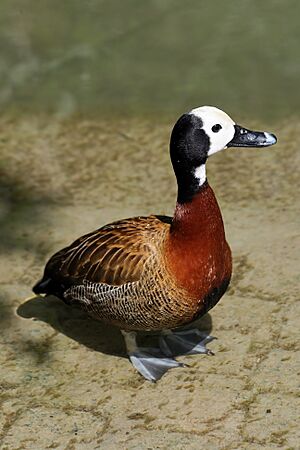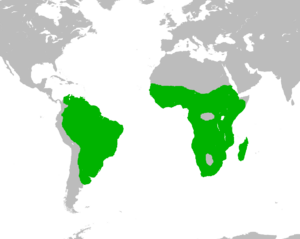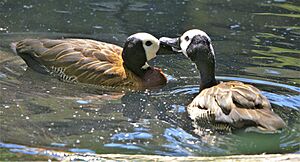White-faced whistling duck facts for kids
Quick facts for kids White-faced whistling duck |
|
|---|---|
 |
|
| Conservation status | |
| Scientific classification | |
| Genus: |
Dendrocygna
|
| Species: |
viduata
|
 |
|
| Range | |
| Synonyms | |
|
Anas viduata Linnaeus, 1766 (protonym) |
|
The white-faced whistling duck (Dendrocygna viduata) is a type of whistling duck. These ducks live and have their babies in parts of Africa (south of the Sahara desert) and a lot of South America.
These ducks love to be with other ducks. They often gather in huge groups, sometimes with thousands of birds. It's an amazing sight to see them arrive at their favorite spots in the morning. As their name suggests, they are quite noisy birds. They make a clear, three-note whistling sound.
Contents
About the White-faced Whistling Duck
This section explains how scientists name and group animals. The white-faced whistling duck was first officially described in 1766. This was done by a Swedish scientist named Carl Linnaeus. He gave it the scientific name Anas viduata.
Later, in 1837, another scientist named William Swainson created a new group (called a genus) for these ducks. He named this group Dendrocygna. The white-faced whistling duck is now one of eight species in this group.
The name Dendrocygna comes from two old words. Dendron means "tree" in Ancient Greek. Cygnus means "swan" in Latin. The word viduata is Latin for "widowed" or "in mourning." This might refer to the duck's black and white colors.
What Does This Duck Look Like?
The white-faced whistling duck has a few special features. It has a long, grey bill (beak), a long head, and long legs. Its neck and head are black. The most noticeable part is its white face, which is how it got its name.
The amount of white on their face can change depending on where they live. For example, ducks in western Africa, where it rains a lot, might have more black on their faces. Their back and wings are dark brown or black. Their belly is black, with thin white stripes on the sides. The neck is a reddish-brown color.
Both male and female ducks look very similar. Young ducks (juveniles) also look like the adults. However, their head pattern is not as clear or bright.
Where Do These Ducks Live?
The white-faced whistling duck lives in two very separate parts of the world. You can find them in Africa and in South America. Some people think that humans might have moved them to new places around the world.
These ducks like to live near fresh water. This includes lakes or reservoirs that have lots of plants growing in them. They eat seeds and other plant parts they find in these watery places.
Because they live in so many different places, these ducks have many common names. Some people call them "irere" or "guiriri."
Daily Life and Habits
The white-faced whistling duck is a very common bird. Most of them stay in one area. However, they might move around locally. These movements can be over 100 kilometers (about 60 miles) or more.
Reproduction and Life Cycle
White-faced whistling ducks build their nests in a dip in the ground or among reeds. A female duck usually lays 6 to 12 eggs. Both the male and female ducks take turns sitting on the eggs to keep them warm.
The eggs hatch after about 26 to 28 days. Both parents take care of the baby ducks, called ducklings. They usually keep the ducklings hidden in the reeds to keep them safe. The ducklings have dark fluffy feathers on top and yellow fluffy feathers underneath. They learn to fly when they are about two months old.
Protecting These Ducks
The white-faced whistling duck is part of an important agreement. This agreement is called the Agreement on the Conservation of African-Eurasian Migratory Waterbirds (AEWA). This means that countries work together to protect these ducks and their homes.
Gallery








